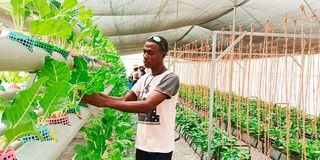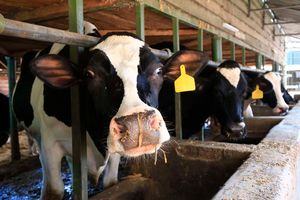Researchers develop electronic soil to enhance crop growth

Vegetables at a hydroponic farm in Tana River County.
What you need to know:
- The e-soil is a low-power bio-electronic growth substrate that can electrically stimulate the root system and growth environment of plants. Derived from cellulose, the substrate is environmentally friendly and will allow for crops to be planted in urban settings, where green spaces are limited.
- The new invention is a creation of scientists from Linkoping University, who intend for it to be tailored to hydroponic cultivation, which involves the technique of growing plants using a nutrient enriched water solution rather than soil.
Human beings have been blamed for depleting earth’s resources faster than the earth can replenish them. With an ever-growing population, scientists project that by 2030, over 600 million people will struggle to feed their families.
In a bid to boost crop growth and production, scientists are proposing a solution, which involves use of ‘electronic soil’, otherwise known as soil-less cultivation. The e-soil is a low-power bio-electronic growth substrate that can electrically stimulate the root system and growth environment of plants. Derived from cellulose, the substrate is environmentally friendly and will allow for crops to be planted in urban settings, where green spaces are limited.
The new invention is a creation of scientists from Linkoping University, who intend for it to be tailored to hydroponic cultivation, which involves the technique of growing plants using a nutrient enriched water solution rather than soil. The water is enriched with Hydrogen, Carbon, Oxygen, Iron, Manganese, Copper, Zinc, Boron, Chlorine, Molybdenum, Nickel, Nitrogen, Phosphorus, Potassium, Calcium, Magnesium and Sulfur.
In this case, plants rely on water, nutrients and a substrate for root support. This closed system allows for water recirculation, ensuring precise nutrient delivery to each seedling. As a result, minimal water is needed, and all nutrients are retained within the system, a feature not achievable in conventional cultivation methods.
According to the study, it would allow for cultivation of crops such as lettuce, herbs and some vegetables.
In the study, scientists found out that barley seedlings that were grown in the electronic soil grew up to 50 per cent more when their root systems were stimulated electrically.
Eleni Stavrinidou, associate professor at the Laboratory of Organic Electronics at Linköping University and leader of the Electronic Plants group, noted that use of hydroponics will allow food to be grown in controlled settings in urban areas.
"The world population is increasing and we also have climate change. So it's clear that we won't be able to cover the food demands of the planet with only the already existing agricultural methods. But with hydroponics we can grow food also in urban environments in very controlled settings," she explained.
"We can't say that hydroponics will solve the problem of food security. But it can definitely help particularly in areas with little arable land and with harsh environmental conditions," she adds.
According to Science Direct, hydroponic farming is considered an alternative to conventional farming systems to reduce water requirements, is beneficial, especially in areas with severe soil degradation and limited water availability, and proves eco-friendly due to no requirement of pesticides and less water requirement. It adds that “less time is required for the yield and there are no soil-borne diseases. Easy management of crops, zero growth of weeds and no requirement for spraying water are among the few advantages of the hydroponic farming system.”
Hydroponic farming has also been praised for its potential to sustainably feed the global population, reclaim vast expanses of land for natural ecosystems, convert organic waste into energy while reducing vermin populations, address water conservation challenges and utilise abandoned urban spaces.
It also has potential to break disease transmission cycles, ensure year-round food production unaffected by climate change, decrease reliance on pesticides, open new opportunities for agrochemical industries, and foster a healthier urban lifestyle for city residents.
However, Timothy Njagi, a Research Fellow at Tegemeo Agricultural Research Institute, says hydroponic farming may take some time before it is embraced in the country as one of the solutions to food insecurity.
He explains that for hydroponic farming to take off in Kenya, technological barriers have to first be addressed and farmers be trained. This, he says, is because this kind of farming depends heavily on technology. Cost and consumer barriers also need to be addressed, he says. “Hydroponic farming is very capital intensive. Farmers struggle to get credit, so it means they will need to finance themselves. We need a study to show the cost of production of hydroponic farming and then compare it with that of conventional farming. For it to be sustainable, the cost of hydroponic farming should be lower than that of conventional farming,” says the researcher.
“We also need to find out whether consumers will be willing and ready to consume food products from hydroponic farms since the taste may be different. If people are hesitant to consume food from greenhouses because of taste preferences, will they consume those from hydroponic farming? You can address food safety issues and nutrition, but the taste profile may need to be addressed,” he says.





